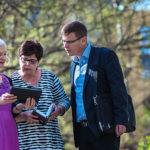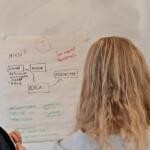
Seija Koskela & Simo Uusinoka
We are sure that as guardians, mothers, and fathers of our children, we all want them to have the best possible future: happy and healthy lives, equal opportunities for good education, and career possibilities suitable for their interests and strengths. Our children should have guidance and counselling from primary to higher education to promote all this.
Our Nepalese–Finnish project (2020–2024), “Developing Pedagogy for 21st Century Skills in Nepal”, funded by the Foreign Ministry of Finland, has partly focused on raising the question of guidance and counselling into discussion and developing higher education teacher training. (HAMK 21STCS Nepal, 2020).
Guidance and counselling as a key to reducing Nepal’s high dropout rates
Both Nepalese high schools and universities have a high dropout rate. Dropping out of high school can easily lead to social exclusion as no alternative study pathways exist. Girls are especially vulnerable in this respect: although 51% of the intake includes well-performing girls, only around 20% of girls from public schools complete their high school studies. Girls in high school could significantly benefit from guidance and counselling services to bolster their motivation and learner agency to complete their studies and empower them to take their place in society. However, although all the students would benefit from appropriate guidance and counselling, a targeted approach would be needed to support girls and other underprivileged groups as they face an even higher risk of not completing their studies. In addition, due to the development of the education system, the role of guidance and counselling will increase as technical and vocational schools are soon integrated into it.
There are numerous challenges that students can face during their studies due to conflict, natural disasters, heavy migration, intercultural issues, and broken families, to name a few. Therefore, all high school and university teachers need professional guidance, counselling skills, and competencies to support students’ learning in fragile situations and environments. The study of guidance and counselling enhances teachers’ competencies in facilitating the study needs of diverse students.
The project involved Tribhuvan University (TU), Nepal Open University (NOU), and two Finnish universities of applied sciences, JAMK University of Applied Sciences and Häme University of Applied Sciences (HAMK). The project aimed to enhance the teachers in Nepal with digital pedagogy and 21st-century skills. Key outputs included a new Master’s program, guidance and counselling study structure, and increased capacity for integrating ICT in education. This article focuses on the collaborative journey to achieve guidance and counselling targets.
What is guidance and counselling
The first task was to have a shared understanding of what we mean by guidance and counselling. As a result of our discussions, we concluded that guidance and counselling support three main areas of life: personal growth and psycho-social questions, learning and studying, and career-related issues. The goals, contents and methods are applied to different age groups of the students according to their needs and developmental phase. The definition of guidance and counselling by the European Lifelong Guidance and Counselling Policy Network (2015) states that lifelong guidance refers to a range of activities that enable citizens of any age and at any point in their lives to:
- Identify their capacities, competencies and interests.
- Makemeaningful educational, training and occupational decisions.
- Manage their life paths in learning, work and other settings in which these capacities and competencies are learned and used. (European Lifelong Guidance and Counselling Policy Network, 2015).
However, one of the most essential contents for all ages is to support them in finding who they are, what their interests are, what their strengths are, and what their developmental challenges might be. When students know themselves, they can start looking for suitable education or career paths. The goal of guidance and counselling is thus to support them in making meaningful and well-informed decisions concerning their future.
When decisions are made based on proper information and students’ interests, the dropout rate decreases, and students’ well-being improves. However, if the decisions are incorrect, the guidance and counselling practitioner helps the students find new options and solutions. The practitioners never make the decisions – the students make – they only help find information. Guidance and counselling practitioners advocate to whom it is easy for the students to turn so that they feel heard, seen and taken seriously.
Guidance and counselling in the global south
Guidance and counselling can be crucial in enhancing educational outcomes in the global south, especially in ensuring that students receive the necessary support to overcome obstacles that might hinder their education. In family-centred societies, the connection between schools and families is essential. Counsellors can foster greater parental involvement in their children’s education, providing a more supportive home environment and enhancing students’ academic success.
In culturally diverse settings, guidance counsellors promote cultural and gender sensitivity, encouraging understanding and respect among students from different backgrounds. This effort contributes to a more inclusive and harmonious school environment.
Guidance counsellors can provide immediate assistance and resources during crises such as natural disasters or personal tragedies in school settings. Their role is crucial in helping students to cope and recover.
Developing guidance and counselling in the project
During the project, TU and NOU developed a 3-credit guidance and counselling course as part of the 21st Century Skills Pedagogy program. In addition to these courses, the course developers and co-creators in NOU concentrated on developing a guidance and counselling course and training manual for in-service teachers and teacher students. The training can be conducted face-to-face or online. (Burns, 2024)
We had the opportunity to attend one face-to-face training session in Kathmandu. It was interesting to observe how the trainers adapted the core elements of guidance and counselling and still applied all the content to the Nepalese context, considering the various cultural differences.
Guidance & Counseling in School Training Manual for Teacher Trainers (2024) consists of three parts and is accessible on the NOU website. The course developers have created a training manual for ten sessions, each lasting fifteen hours, and worth three credits. The first part of the manual consists of approaches to explore individual and group counselling challenges and needs of the students. It also includes counselling in school and society, describing the significance of guidance and counselling in human life. (Khadka, 2024).
Given the numerous academic, social and vocational challenges that teachers regularly encounter in their professional roles, the practical examples in this section are intended to facilitate discussions on the counselling needs and processes. Furthermore, this section offers invaluable advice to teachers on how to effectively handle these situations.
Likewise, the third part of the manual comprises strategies for supporting students, and different approaches are adapted to help them. The Sociocultural Approach, Problem-Solving Approach, and Inquiry Approach (Appreciative Inquiry) are major approaches included in this manual.
During the project, NOU developed the first-ever MOOC (massive open online course) based on the guidance and counselling training manual. The MOOC training course prepares teachers to build their capacity and guide and counsel students to improve their academic competencies, manage their personal and socio-emotional skills, and choose their careers. This course consists of individual and group counselling and how the process of counselling takes place in school and society. The course can be found on the NOU web pages.
Conclusions
Guidance and counselling are not entirely new concepts in Nepal. Different school levels or education providers must still adapt it as a compulsory curriculum element. The Nepalese society now faces enormous challenges, such as the emigration of the young, high dropout rates, and social exclusion, which require immediate attention. Although guidance and counselling won’t solve all the problems and challenges from the individual’s or the society’s perspective, it can ease some of them. If young people receive guidance and counselling during their school years, they might be more aware of what the education system and the world of work have to offer for them in the future.
Guidance and counselling can also impact the traditional role and work of the teacher. Beyond delivering materials, teachers with guidance and counselling expertise design, guide, and assess student learning. They create meaningful connections with learners. These competencies also help teachers understand diverse student needs. Whether talented, average, or struggling, every student deserves personalized support.
In Nepal, girls face unique challenges. Guidance and counselling services can strengthen their motivation, agency, and resilience. When girls succeed, society benefits. Additionally, students from marginalized backgrounds – affected by conflict, natural disasters, migration, or broken families – need tailored support. Guidance and counselling can bridge these gaps.
Authors
Seija Koskela works as a Senior Lecturer at Jamk University of Applied Sciences, School of Professional Teacher Education (SPTE) in Jyväskylä, Finland. Her main responsibility is in the training of career guidance and counselling professionals the key expertise area being developing multidisciplinary collaboration. She has also been involved as an expert and trainer in several national and international projects in the field of guidance and counselling.
Simo Uusinoka works as a Senior Lecturer at Häme University of Applied Sciences, School of Professional Teacher Education. His primary role involves training future vocational special needs teachers. Additionally, he has extensive experience as a trainer in various international development projects within the education sector.
References
Burns, E. (2024). Guidance and Counselling in School – Training manual for teacher trainers. Jamk. https://www.jamk.fi/en/article/guidance-and-counselling-in-school-training-manual-for-teacher-trainers
European Lifelong Guidance Policy Network (ELGPN). (2015). Guidelines for policies and systems development for lifelong guidance: A reference framework for the EU and for the Commission. ELGPN Tools No. 6. elgpn.eu/publications/browse-by-language/english/elgpn-tools-no-6-guidelines-for-policies-and-systems-development-for-lifelong-guidance/
HAMK. (2020). 21STCS NEPAL. Developing Pedagogy for 21st Century Skills in Nepal. https://www.hamk.fi/en/projects/developing-pedagogy-for-21st-century-skills-in-nepal-21stcs-nepal/
Khadka, J. (ed.) (2024). Guidance & counseling in school. Training manual for teacher trainers. 21st CS Developing Pedagogy for Nepal. Nepal Open University. https://issuu.com/eibur/docs/final_guidance_and_counselling_book





